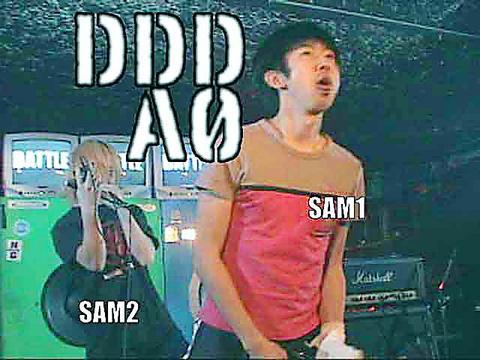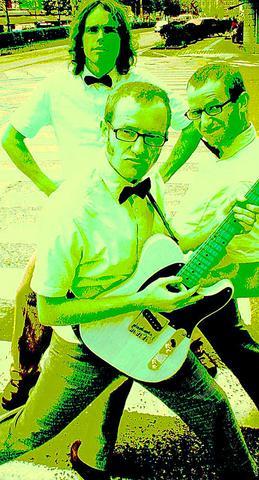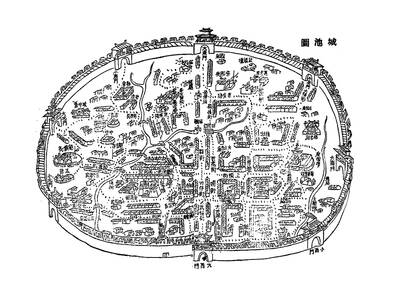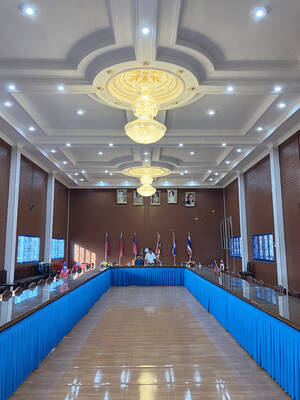The 10th Spring Scream could be one for the purists, as founders Jimi Moe and Wade Davis stage a 10-day festival that aims to recover the spirit of the event's early years. It will also build up to what's become known as Spring Scream weekend, which has sprouted into a massive jamboree of other art festivals, raves on the beach, and hotel or club parties in and around Kenting.
The festival started today at its usual location, nestled in a few of Kenting National Park's fields near Liou Fu San Juang, and will have music every day until it kicks into high gear next weekend.
"Some people confuse Spring Scream with all the other stuff [dance music events] that goes on. Nobody's gone out to call their event Spring Scream, though there've been variations of it. But the name's stuck, I think, because it's a catchy phrase and looks good on a headline. Some people who've never been to Spring Scream think they've been because they went to a party on the beach at the same time," Davis said.

PHOTO COURTESY OF SPRING SCREAM
Moe and Davis started the festival in 1995 when a few musicians and artists set up the first arts-music festival at Magic Studios, near the Kenting National Park entrance. After being held in different places, the weekend settled six years ago on its current site and grew over the years to its present size: 10 days, three stages, 205 bands scheduled (125 bands on standby), an art and film festival, stalls, workshops, and more.
Separate dance music events got in on the act four years ago and the crowds have multiplied, along with the media presence, which has painted the whole scene in terms of general bacchanalian abandon.
As a result of this not entirely undeserved image (and a drowning death two years ago), there has been increased police attention. Officers swooped on five out of seven parties on one night last year, citing suspicion of drugs on the "premises" as the reason for the raids.

PHOTO COURTESY OF SPRING SCREAM
ISOLATION POLICY
Spring Scream has kept itself largely isolated from this madness by virtue of its longstanding reliability, being further away from the town center, closing down at 12pm, and because of the relationships it has cultivated with the authorities and local residents. It has also strongly disassociated itself from the other parties.

PHOTO COURTESY OF SPRING SCREAM
"It's two different crowds, maybe 3 percent to 8 percent of the crowd that comes down for the dancing will come to Scream, but I reckon the figures are more like 6,000 to 10,000 of them, and 2,000 rockers. Their influence is much larger than ours, they're a different demographic to us. The more people I talk to, the more I realize that we don't have the same crowds," Moe said.
"For the last four years I've just hated the dance music thing, I just despised it, putting a needle on plastic and calling it music. I guess I always appreciated scratch. Now I'm impressed with some electronica ... It's come a long way and that's why we've started putting it on."
As for the drugs that have plagued the party weekend, Davis said they weren't a problem for Spring Scream. "We've never been raided. The first year at the beach there was a noise complaint, so we moved it and took it off the beach and that was it. We've never been raided, there have been no arrests or anything in six years."

INEVITABLE CHANGE
Both Moe and Davis said, in separate telephone interviews, that they recognized the Spring Scream weekend has changed and accept they will have to adapt too. They are considering sponsorship, but are worried about their principles.
"Change or not has been the eternal question. We might be in the minority, everyone else is backed by the technology and the media, but we're keepin' it live. Even so, we know change is inevitable," Moe said.
The only problem is everyone has a different idea of how Spring Scream should meet the challenge of the next 10 years. Moe and Davis want to please everyone, but realize they have to blow off some of their audience to keep reaching new audiences. Or blow off new audiences, to keep the loyal Spring Screamers.
"The more people that come, the more bi-polar they are. There are the traditionalists who want it to be how it was five or 10 years ago and complain, `Oh, it's not so intimate.' And then there are the others saying, `We want it like Saturday night, every night.' You can't win," Moe said.
"We started as an arts-music festival and I think we've stayed true to that. We've kept prices down and avoided sponsorship, we've been into non-branding. Maybe we need to change."
As far as the blueprint for Spring Scream is concerned -- live music, field, no DJs, finish at 12 -- it may have to change as thousands troop to hear one DJ and hundreds turn up for 100 bands. One idea is international headliners, another is getting in bed with a sponsor.
"People have a good time, so we don't want to change it, but if we do it will need sponsors, international bands. Maybe that is a direction we have ignored and it is our own fault. We get so caught up in making ends meet, maybe we've not been so open to things as we should have been," Davis said.
TAKEN TO BED
Talking about how Glastonbury in the UK evolved into a festival that included all genres of music, Moe said things could be different next year, with a new format. "Maybe there will be a `Kentingbury' next year. Nah. This year we've got 10 days of music with three stages, next year it could be three days and 10 stages. We wanna push the envelope. No matter what you do, you have to second-guess yourself. When we realized we had committed ourselves to 10 days and couldn't turn back we thought, whatever, we can turn it round next year."
Looking forward to another 10 years of Spring Scream, Davis said, "We started with the idea of bands and making original music, here, in Asia. That's what we decided to concentrate on and support, and from that perspective it has worked. At this point, it all works, dance music doesn't need our support. The idea is that you have to pick your tree out of the forest. And that's what we've done. We could take it toward Fuji Rock [Japan]."
This year, however, it's going to be a back-to-to-their-roots Spring Scream, with 10 days of fun in the sun. "What we do say is if it's not fun then we won't be doing it. ... But I do get a kick from it, especially when someone has a story to tell. And they always do," Moe said.
"There was this full-on rock star last week and I told him what I did and he said, `Kenting? No way. I was there, like, seven years ago, we had sarongs and climbed on this hill and, like, flashed everyone.' Everyone who's been has a story, even if some of them nowadays are about the traffic and the noise. It's usually about the first time they saw a band, or met their wife. A lot of stories about Christmas babies, too."

May 26 to June 1 When the Qing Dynasty first took control over many parts of Taiwan in 1684, it roughly continued the Kingdom of Tungning’s administrative borders (see below), setting up one prefecture and three counties. The actual area of control covered today’s Chiayi, Tainan and Kaohsiung. The administrative center was in Taiwan Prefecture, in today’s Tainan. But as Han settlement expanded and due to rebellions and other international incidents, the administrative units became more complex. By the time Taiwan became a province of the Qing in 1887, there were three prefectures, eleven counties, three subprefectures and one directly-administered prefecture, with

Taiwan Power Co (Taipower, 台電) and the New Taipei City Government in May last year agreed to allow the activation of a spent fuel storage facility for the Jinshan Nuclear Power Plant in Shihmen District (石門). The deal ended eleven years of legal wrangling. According to the Taipower announcement, the city government engaged in repeated delays, failing to approve water and soil conservation plans. Taipower said at the time that plans for another dry storage facility for the Guosheng Nuclear Power Plant in New Taipei City’s Wanli District (萬里) remained stuck in legal limbo. Later that year an agreement was reached

What does the Taiwan People’s Party (TPP) in the Huang Kuo-chang (黃國昌) era stand for? What sets it apart from their allies, the Chinese Nationalist Party (KMT)? With some shifts in tone and emphasis, the KMT’s stances have not changed significantly since the late 2000s and the era of former president Ma Ying-jeou (馬英九). The Democratic Progressive Party’s (DPP) current platform formed in the mid-2010s under the guidance of Tsai Ing-wen (蔡英文), and current President William Lai (賴清德) campaigned on continuity. Though their ideological stances may be a bit stale, they have the advantage of being broadly understood by the voters.

In a high-rise office building in Taipei’s government district, the primary agency for maintaining links to Thailand’s 108 Yunnan villages — which are home to a population of around 200,000 descendants of the Chinese Nationalist Party (KMT) armies stranded in Thailand following the Chinese Civil War — is the Overseas Community Affairs Council (OCAC). Established in China in 1926, the OCAC was born of a mandate to support Chinese education, culture and economic development in far flung Chinese diaspora communities, which, especially in southeast Asia, had underwritten the military insurgencies against the Qing Dynasty that led to the founding of